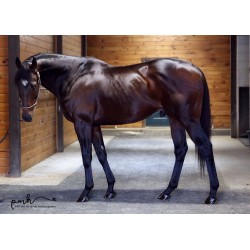













The Thoroughbred is a horse breed best known for its use in horse racing. Although the word thoroughbred is sometimes used to refer to any breed of purebred horse, it technically refers only to the Thoroughbred breed.
 Security policy (edit with Customer reassurance module)
Security policy (edit with Customer reassurance module)
 Delivery policy (edit with Customer reassurance module)
Delivery policy (edit with Customer reassurance module)
 Return policy (edit with Customer reassurance module)
Return policy (edit with Customer reassurance module)
The Thoroughbred is a horse breed best known for its use in horse racing. Although the word thoroughbred is sometimes used to refer to any breed of purebred horse, it technically refers only to the Thoroughbred breed. Thoroughbreds are considered "hot-blooded" horses that are known for their agility, speed, and spirit.
The Thoroughbred as it is known today was developed in 17th- and 18th-century England, when native mares were crossbred with imported Oriental stallions of Arabian, Barb, and Turkoman breeding. All modern Thoroughbreds can trace their pedigrees to three stallions originally imported into England in the 17th and 18th centuries, and to a larger number of foundation mares of mostly English breeding. During the 18th and 19th centuries, the Thoroughbred breed spread throughout the world; they were imported into North America starting in 1730 and into Australia, Europe, Japan and South America during the 19th century. Millions of Thoroughbreds exist today, and around 100,000 foals are registered each year worldwide.
Thoroughbreds are used mainly for racing, but are also bred for other riding disciplines such as show jumping, combined training, dressage, polo, and fox hunting. They are also commonly crossbred to create new breeds or to improve existing ones, and have been influential in the creation of the Quarter Horse, Standardbred, Anglo-Arabian, and various warmblood breeds.
Thoroughbred racehorses perform with maximum exertion, which has resulted in high accident rates and health problems such as bleeding from the lungs. Other health concerns include low fertility, abnormally small hearts and a small hoof-to-body-mass ratio. There are several theories for the reasons behind the prevalence of accidents and health problems in the Thoroughbred breed, and research is ongoing.
The typical Thoroughbred ranges from 15.2 to 17.0 hands (62 to 68 inches, 157 to 173 cm) high, averaging 16 hands (64 inches, 163 cm). They are most often bay, dark bay or brown, chestnut, black, or gray.[1] Less common colors recognized in the United States include roan and palomino. White is very rare, but is a recognized color separate from gray.[2] The face and lower legs may be marked with white,[3] but white will generally not appear on the body. Coat patterns that have more than one color on the body, such as Pinto or Appaloosa, are not recognized by mainstream breed registries.[2][4] Good-quality Thoroughbreds have a well-chiseled head on a long neck, high withers, a deep chest, a short back, good depth of hindquarters, a lean body, and long legs.[3][5] Thoroughbreds are classified among the "hot-blooded" breeds, which are animals bred for agility and speed and are generally considered spirited and bold.[6]
Thoroughbreds born in the Northern Hemisphere are officially considered a year older on the first of January each year;[7] those born in the Southern Hemisphere officially are one year older on the first of August.[8] These artificial dates have been set to enable the standardization of races and other competitions for horses in certain age groups